|
abot82-6a
|
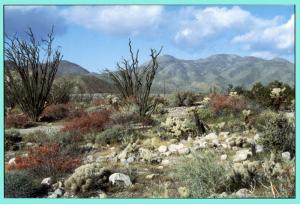
|
The Anza Borrego Desert in bloom. This picture was taken in the Anza-Borrego Desert State Park in northeastern San Diego County in March 1978.
|
copyright: Lisa Baird, BSA
license: http://images.botany.org/index.html#license |
Image
|
Unclassified

|

|
|
abot82-7
|
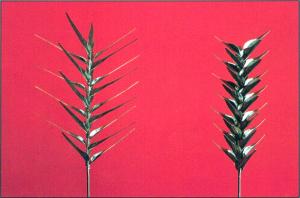
|
Silver-plated models of Sphagnum branches were employed in studies of boundary layer properties. The model based on morphology of S. trinitense (left; an aquatic species) generated thinner boundary layers than the S. recurvum model (right; a nonaquatic species) when evaluated in an electrochemical fluid tunnel. Models are 10 times life size with the branch axes 10 cm long.
|
copyright: Steven K. Rice, BSA
license: http://images.botany.org/index.html#license |
Image
|
Structure and Development

|

|
|
abot82-8
|
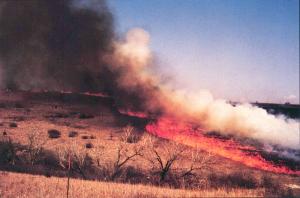
|
Fire is an inherent feature of the tallgrass prairie ecosystem. Prescribed fires have been conducted on Konza Prairie Research Natural Area for over 20 yr. The interactions of fire, landscape, and abiotic factors on aboveground biomass are examined.
|
copyright: John M. Briggs, BSA
license: http://images.botany.org/index.html#license |
Image
|
Ecology and Phytogeography

|

|
|
abot82-9
|
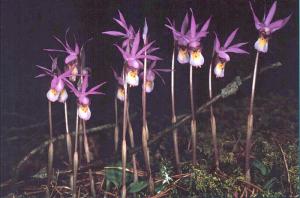
|
Group of Calypso bulbosa (Orchidaceae) from the rocky Mountain foothills west of Calgary, Alberta, Canada. After receiving pollen, these flowers undergo rapid changes in color and shape, but the rate of change is unaffected by the amount of pollen deposited. Removal of a flower's own pollen does not cause color or shape changes.
|
copyright: Heather C. Proctor, BSA
license: http://images.botany.org/index.html#license |
Image
|
Reproductive Biology

|

|
|
abot83-1
|
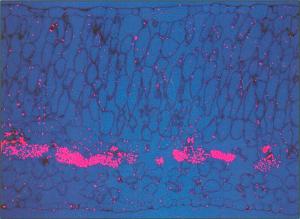
|
Cross section of a mature leaf of Vigna mungo, immunolabelled using an antibody raised against soybean leaf vegetative storage protein 27/29 (VSP 27/29) Pink dots indicate where the VSP 27/29 is present, demonstrating its accumulation in a specialized tissue called the paravenial mesophyll is present in many legume species, a number of which have now been found to accumulate VSPs in this specialized tissue. A unique role in nitrogen assimilation and turnover is implicated for legume PVM. Composite of reflected image of silver-enhanced gold label (pink) and transmitted image of leaf cells (blue).
|
copyright: -
license: http://images.botany.org/index.html#license |
Image
|
Physiology and Biochemistry

|

|
|
abot83-10
|
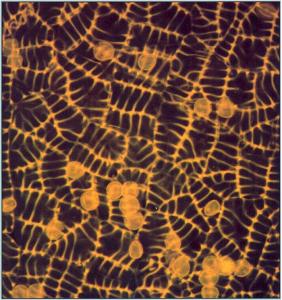
|
Whole mount of fragment of sporangial epidermis from a Sphagnum girgensohnii capsule subjected to high temperature acid hydrolysis. All cell walls have survived due to presence of resistant, autofluorescentwall compounds.Cell sizes,shapes, and patterns closely resemble those of Ordovician and later microfossils classified as "dispersed cuticles." This suggests that the mose ancient microfossils consisting of cellular sheets may represent some of the earliest known remains of plant sporophytic tissues.
|
copyright: -
license: http://images.botany.org/index.html#license |
Image
|
Structure and Development

|

|
|
abot83-11
|
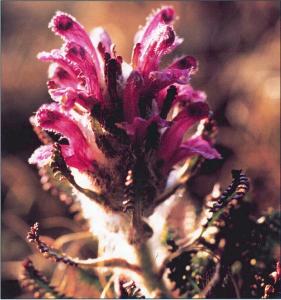
|
Pedicularis dasyantha in Svalbard, Norway
|
copyright: -
license: http://images.botany.org/index.html#license |
Image
|
Genetics and Molecular Biology

|

|
|
abot83-12
|
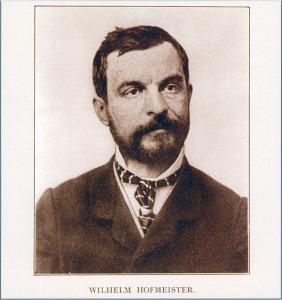
|
Portrait of Wilhelm Hofmeister (age unknown) orginally published in The plant World by Goebel, 1905.
|
copyright: -
license: http://images.botany.org/index.html#license |
Image
|
Historical Botany

|

|
|
abot83-2
|
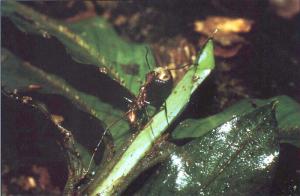
|
A myrmicine ant, Aphaenogaster araneoides, carrying a seed of a neotropical understory herb, Calathea micans (Marantaceae). Ant-planted chasmogamous and cleistogamous seeds differed in establishment success in understory and gap sites.
|
copyright: -
license: http://images.botany.org/index.html#license |
Image
|
Reproductive Biology

|

|
|
abot83-3
|
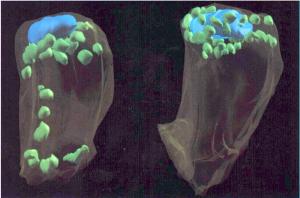
|
Computer-generated reconstruction from serial ultrathin sections showing the distribution of plastids within the egg cells of two genotypes of alfalfa. In the egg on the left, plastids (green) are positioned mostly below (toward the micropyle) the midtransverse region of the nucleus (blue) which results in the female plastids being largely sequested within the basal cell of the two-celled proembryo and not inherited. In the cell on the right, the plastids are perinuclear, thus, many female plastids become included in the apical cell of the two-celled proembryo and are inherited.
|
copyright: -
license: http://images.botany.org/index.html#license |
Image
|
Special Invited Paper

|

|
|
abot83-4
|
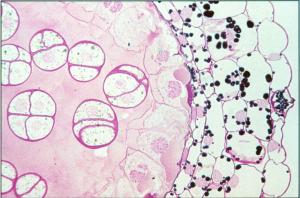
|
Cross section of Lilium at the tetrad stage stained with the PAS polysaccharide specific reaction. Soluble carbohydrates are detected within the locular fluid and the tapetum, whereas starch grains are accumlated in the outer anther wall layers (epidermis, endothecium, and middle layers).
|
copyright: -
license: http://images.botany.org/index.html#license |
Image
|
Reproductive Biology

|

|
|
abot83-5
|
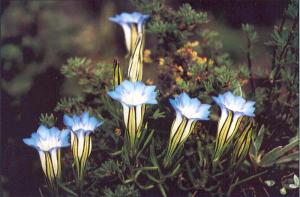
|
Gentiana sino-ornata Balf f. (Sect. Monopodiae) distributed in the mountains of southwest China and adjacent Burma, is one of the most magnificent gentians in the world. It was introduces into Europe in the early decades of this century and has contributed much to the botanical gardens of Europe. However, the individuals growing in their native land look more lovely. The photo was taken from Aba (3,200 m) Sichuan, China.
|
copyright: -
license: http://images.botany.org/index.html#license |
Image
|
Systematics and Phytogeography

|

|
|
abot83-6
|
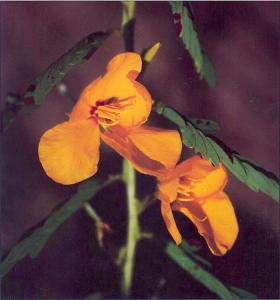
|
Chamaecrista fasciculata
|
copyright: -
license: http://images.botany.org/index.html#license |
Image
|
Structure and Development

|

|
|
abot83-6a
|
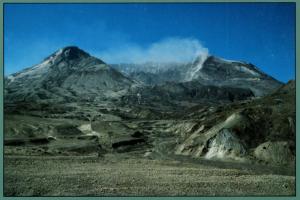
|
Ground leve view of Mt. St. Helens in August of 1986. This picture shows the breach with the dome and erosion features and how the landscape is developing: plants are scarce.
|
copyright: -
license: http://images.botany.org/index.html#license |
Image
|
Ecology

|

|
|
abot83-7
|
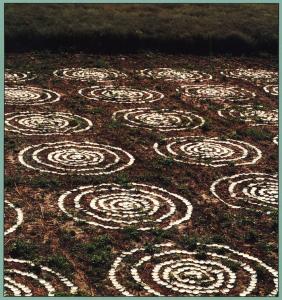
|
Concentric rings of seed traps around individual parent plants of Lepidium campestre (Brassicaceae) used to document the distance and directional components of an individual's seed dispersion pattern in the absence of vegetation.
|
copyright: -
license: http://images.botany.org/index.html#license |
Image
|
Population Biology

|

|
|
abot83-8
|
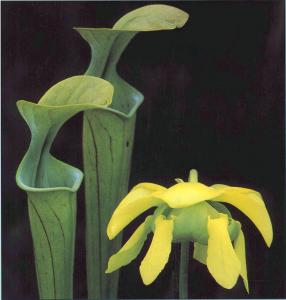
|
The federally endangered green pitcher plant (Sarracenia oreophila Sarraceniaceae) in flower. Thirty-five populations of this insectivorous perennial species remain in the southeastern U.S. Allozyme diversity is low in this species; small populations and geographically disjunct populations maintain the least genetic diversity.
|
copyright: -
license: http://images.botany.org/index.html#license |
Image
|
Population Biology

|

|
|
abot83-9
|
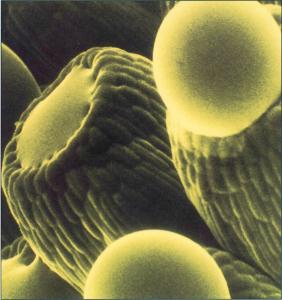
|
Pollination drops inside an ovulate cone of Sequoiadendron. These drops persist undisturbed during wet periods, since a water sheet forms on the wettable cone surface. Pollen capture resumes immediately after the cone dries.
|
copyright: -
license: http://images.botany.org/index.html#license |
Image
|
Reproductive Biology

|

|
|
abot84-1
|
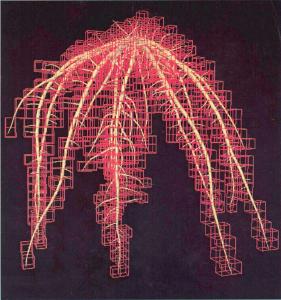
|
The growth of a bean (Phaseolus vulgaris L.) root system for 10 d, as simulated by SimRoot, a dynamic simulation model of botanical root systems based on empirical growth parameters. The three-dimensional fractal dimension of the root system was estimated by superimposing three-dimensional grids of varying size on the simulated root system in order to estimate the number of boxes in the three dimensional grid that was intercepted by the simulated root system.
|
copyright: -
license: http://images.botany.org/index.html#license |
Image
|
Structure and Development

|

|
|
abot84-10
|
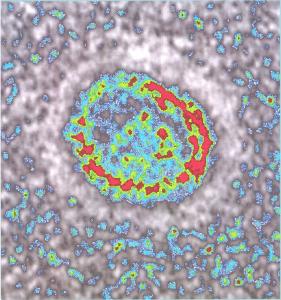
|
Transverse view showing internal structure of a plasmodesma of the charophycean green alga Chara zeylanica. Digital false color computer-enhanced image from a tramission electron micrograph. A central structure appears to be connected to the plasma membrane via spoke-like structures, a feature held in common with plasmodesmata of higher plants.
|
copyright: -
license: http://images.botany.org/index.html#license |
Image
|
Evolution

|

|
|
abot84-11
|
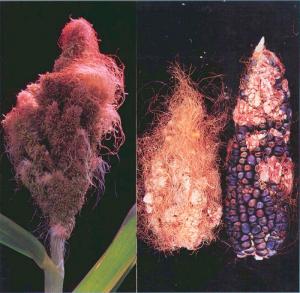
|
Tassel seed mutations in maize. Maize plants bear two different types of inflorescences, the tassel and the ears. The tassel is branched and has made flowers, while the ears are unbranched and have female flowers. This occurs by formation of initially hermaphroditic flowers, followed by the selective abortion of male reproductive organs (stamens) in ear flowers and of female reproductive organs (pistils) in tassel flowers. the tassel seed mutations alter this pattern by allowing pistils to develop in flowers on the tassel seed mutations, such as Ts6 and ts4, also cause extra branches to form in the tassel (Ts6, left) and on the ear (Ts6, right; ts4, center).
|
copyright: -
license: http://images.botany.org/index.html#license |
Image
|
Development and Morphogenesis

|

|